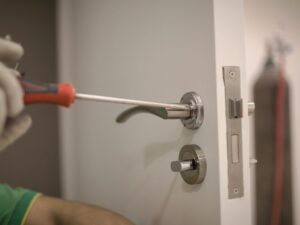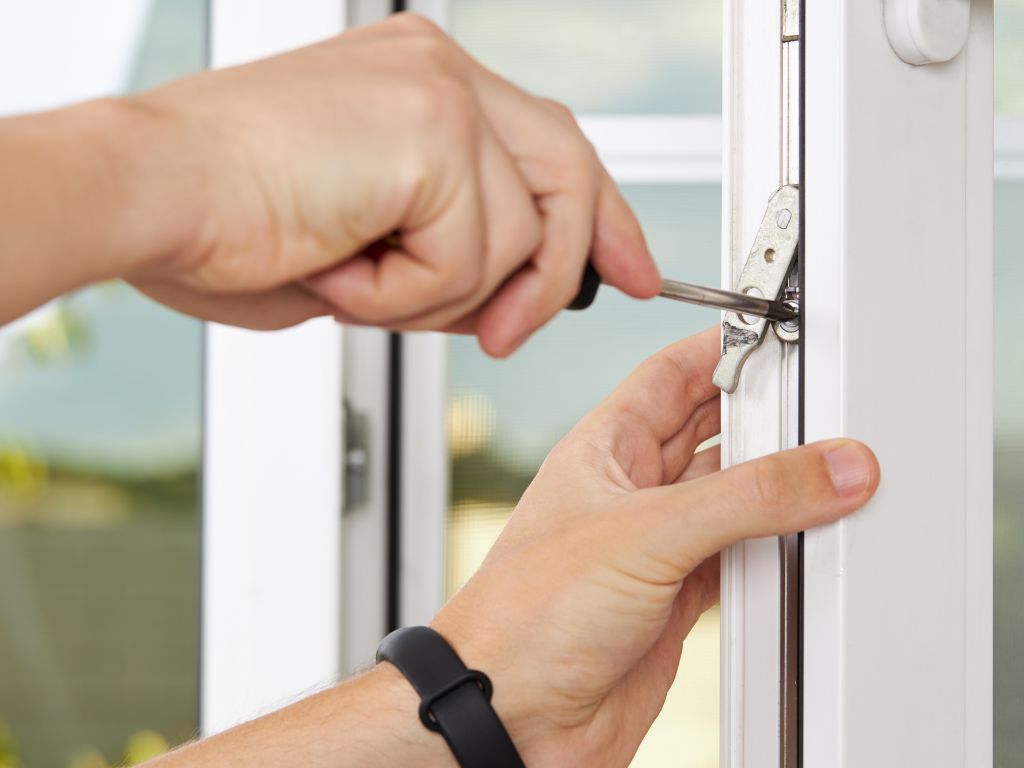
- 01708 453168
- info@atcl.co.uk
- Office Hours: Mon - Sat: 7:30 - 17:30
- 24hr Emergency Callout

When it comes to the security and the comfort of our homes, doors play a crucial role. However, the constant use of doors, particularly UPVC doors, such as front, patio and french doors, may lead to wear and tear over time, resulting in issues like improper closing. Not only does this compromise your home’s security, but it also impacts energy efficiency.
UPVC, or Unplasticized Polyvinyl Chloride, is a versatile material widely used in door and window manufacturing. Its popularity stems from its cost-effectiveness, insulation properties, and resistance to weather elements compared to traditional materials like wood or metal. However, despite their durability, UPVC doors are not immune to problems.
This blog will delve into why your UPVC doors are not closing correctly and offer practical solutions to address these issues.
Another common cause of UPVC doors failing to close properly is temperature changes. UPVC is a material sensitive to temperature fluctuations, expanding in hot weather and contracting in colder conditions. This can lead to the door not fitting correctly into the frame, making it difficult to close. A solution to this is to adjust the door during varying weather conditions. Sometimes, a professional might have to resize or reposition the door and frame to ensure a proper fit, regardless of the weather.
Over time or in extreme conditions, these doors may still experience swelling (usually in humid or wet conditions) or shrinking (in dry conditions). Swelling can cause the door to become too large for the frame, making it difficult to close, while shrinking can create gaps between the door and the frame, compromising the security and insulation of your home. Extreme swelling or shrinking could be an indicator of a more severe issue that requires professional intervention. Sometimes, the door may need to be replaced entirely, particularly if it has become warped or is no longer structurally sound. Thus, regular maintenance and check-ups are crucial to ensure your UPVC doors remain in good condition and function optimally.
If you suspect that your UPVC door is misaligned, there are some simple checks you can conduct to confirm your suspicions. First, look at the gap between the door and the frame. It should be even all around. If you notice that the gap is wider at the top or bottom, your door is likely misaligned.
To further examine the alignment, open and close the door, paying attention to any resistance or scraping sounds. If the door is difficult to open or close or if you observe any scraping, it’s a clear sign of misalignment. Another helpful tip is to open the door halfway and then let go. If it swings significantly in either direction, likely, the door is not levelled correctly.
Yes, fixing a UPVC door misalignment is possible, provided you have basic DIY skills and the right tools. However, it’s important to exercise caution to prevent causing further damage to the door or the frame. Here’s a simple guide:
Remember, it’s best to call a professional UPVC door repair locksmith if you’re uncomfortable doing this yourself or if the door still needs to align appropriately after your efforts. Incorrectly adjusting the door could exacerbate the problem or cause damage to the door or frame.
Several signs can indicate underlying issues when determining if a UPVC door is damaged. Foremost, difficulty in opening or closing the door is a clear indication of damage. Other telltale signs may include a visible gap between the door and the frame or drafts coming through the door.
Cracks or chips in the UPVC material, rust, or other noticeable deterioration on the hinges or door handle are also clear signs of damage. Similarly, if your door makes unusual noises during operation, such as scraping or creaking, it’s likely damaged.
Lastly, if the door’s lock is difficult to engage or disengage, this could indicate a damaged or worn-out mechanism within the door.
If your UPVC door lock is not working, it can lead to many issues, including compromised security and loss of heat insulation. The problem could be due to various reasons, such as a faulty cylinder, misalignment of the door, wear and tear over time, or a damaged key.
The cylinder might need replacing if you’re having trouble locking or unlocking the door. A misaligned door can pressure the lock, making it harder to operate. Over time, the components inside the lock can wear out, and you might notice the key turning in the lock more stiffly. If the key is damaged, the lock might not work correctly.
Remember, while minor issues like lubricating the lock or tightening screws can be handled at home, more severe problems like a misaligned door or a faulty cylinder should be addressed by a professional. Always pay attention to the early signs of a failing lock to prevent more significant issues in the future.
Although minor UPVC door issues can be handled through simple DIY fixes, some situations necessitate a professional locksmith’s expertise. If you’re experiencing persistent problems with door alignment despite several adjustments, it’s time to call a pro.
Similarly, a locksmith should examine when your lock mechanism becomes stiff or the key won’t turn smoothly. Any signs of damage, such as cracks, chips, or noticeable deterioration on hinges, also warrant professional attention. Additionally, if the door’s lock fails to engage or disengage quickly, you might be dealing with a damaged or worn-out mechanism that requires a locksmith’s intervention.
Delaying or ignoring these signs may lead to more serious issues, potentially compromising your home’s security and insulation.
Maintaining and enhancing the longevity of your UPVC doors requires regular care and preventative measures. Following are some essential tips to keep your UPVC doors in top shape:
Incorporating these simple yet effective practices into your regular home maintenance routine can go a long way in preserving the durability and efficiency of your UPVC doors. These steps will help keep your doors functioning smoothly and extend their lifespan, saving you the cost and hassle of frequent replacements.
Moreover, being mindful of early signs of damage and addressing them promptly can prevent minor issues from escalating into major problems. Whether it’s a small task like applying lubricant to a stiff lock or a more complex job requiring professional assistance, such as rectifying door misalignment or replacing a faulty cylinder, each action contributes to upholding the overall integrity of your UPVC door.
Regular care and timely interventions are important to ensure your UPVC doors are in top shape and ensure a secure, comfortable, and energy-efficient environment in your home.
Remember, don’t hesitate to consult a professional locksmith when in doubt. After all, your home’s safety and insulation are worth the investment.
EXCELLENTTrustindex verifies that the original source of the review is Google. Lovely young chap (Dan Payne) came this morning to change my elderly mother's locks. He was polite, helpful and swift. Did the job to a high standard. Will use the company again. Thank you!Posted onTrustindex verifies that the original source of the review is Google. Fantastic service! Dan came to change a lock, arrived early which I was really happy about and he was very polite on arrival. Super professional, changed the lock in no time and left no mess. Would definitely recommend 👍Posted onTrustindex verifies that the original source of the review is Google. one of the locksmiths (didn’t get the name) came and swapped out my lock today having called my council yesterday evening, they rang and I wasn’t home but they waited for me to get back. They were lovely and he was very quick so thank you.Posted onTrustindex verifies that the original source of the review is Google. Excellent service, got here in 20 minutes, had the front door open in less than 30 seconds! Thank you!Posted onTrustindex verifies that the original source of the review is Google. I have just used Around The Clock Locks (ATCL) Locksmiths and they are very professional, affordable and brilliant. They have resolved my French door lock issue within minutes and explained everything clearly. They came right on time and only start the job once we agreed the price which was very competitive. I appreciate their honesty also. I whole heartedly recommend ATCLPosted onTrustindex verifies that the original source of the review is Google. Amazing service, reasonably priced and helped me with a few other niggles I had in the property. Would highly recommendPosted onTrustindex verifies that the original source of the review is Google. Really responsive, friendly service, great work every time. Many thanksPosted onTrustindex verifies that the original source of the review is Google. I had a problem with the locks in my flat, after getting quotes from two other locksmiths, ACTL turned out to be the most responsive and reasonably priced by far. They replaced the locks (and door handle) quickly. Everything looks and works perfectly now. I also REALLY appreciated that all communication could be handled via email - no unnecessary phone calls, which was a hassle with other companies.Posted onTrustindex verifies that the original source of the review is Google. Amazing. Oliver arrived within 10 mins of my call and got my into my home quickly. He also kindly helped with a separate issue with my door. Highly recommended. Thanks so much